How Many Animals Are Tested On Each Day
What have humans gained from creature testing? Are we getting closer to finding a cure for HIV, cancer, and other diseases through animal experiments? These eleven animal testing statistics will help you lot sympathize how animal experiments (don't) work and what nosotros're (non) getting out of them.
1. Each year, more than 110 meg animals—including mice, frogs, dogs, rabbits, monkeys, fish, and birds—are killed in U.S. laboratories.
Experimenters force animals to inhale toxic fumes, immobilize them in restraint devices, drill holes into their skulls, mutilate their brains, and burn down their skin and eyes—and if the animals don't die in the process, they're killed afterward. Whether it's for biology lessons, medical preparation, curiosity-driven experiments, or chemical, drug, food, or cosmetics testing, these animals are confined to barren cages, socially isolated, and psychologically traumatized.

Covance Cruelty
2. Ninety-five percentage of all drugs that are shown to be prophylactic and effective in fauna tests neglect in human trials.
This stat comes straight from the National Institutes of Wellness (NIH)—the regime agency that funnels billions of our taxpayer dollars into these reckless experiments. NIH has noted that the drugs fail in humans considering they either don't work or are dangerous. Because animal trials are so unreliable, they brand human being ones more than risky.


3. 90-nine percent of the animals used in laboratories aren't covered by federal creature protection laws.
It'southward as if the authorities were saying, "I'm deplorable, but you're just non animal plenty" to the tens of millions of rats, mice, birds, fish, reptiles, and amphibians who plant 99% of the animals used in laboratories still are excluded by the federal Animal Welfare Act (AWA) and therefore denied fifty-fifty the most basic consideration. However, even animals who are supposedly "protected" under the AWA are however allowed to be burned, shocked, poisoned, isolated, starved, restrained, made addicted to drugs, and brain-damaged. No test—no affair how painful or piffling—is illegal. And pain relief isn't required.
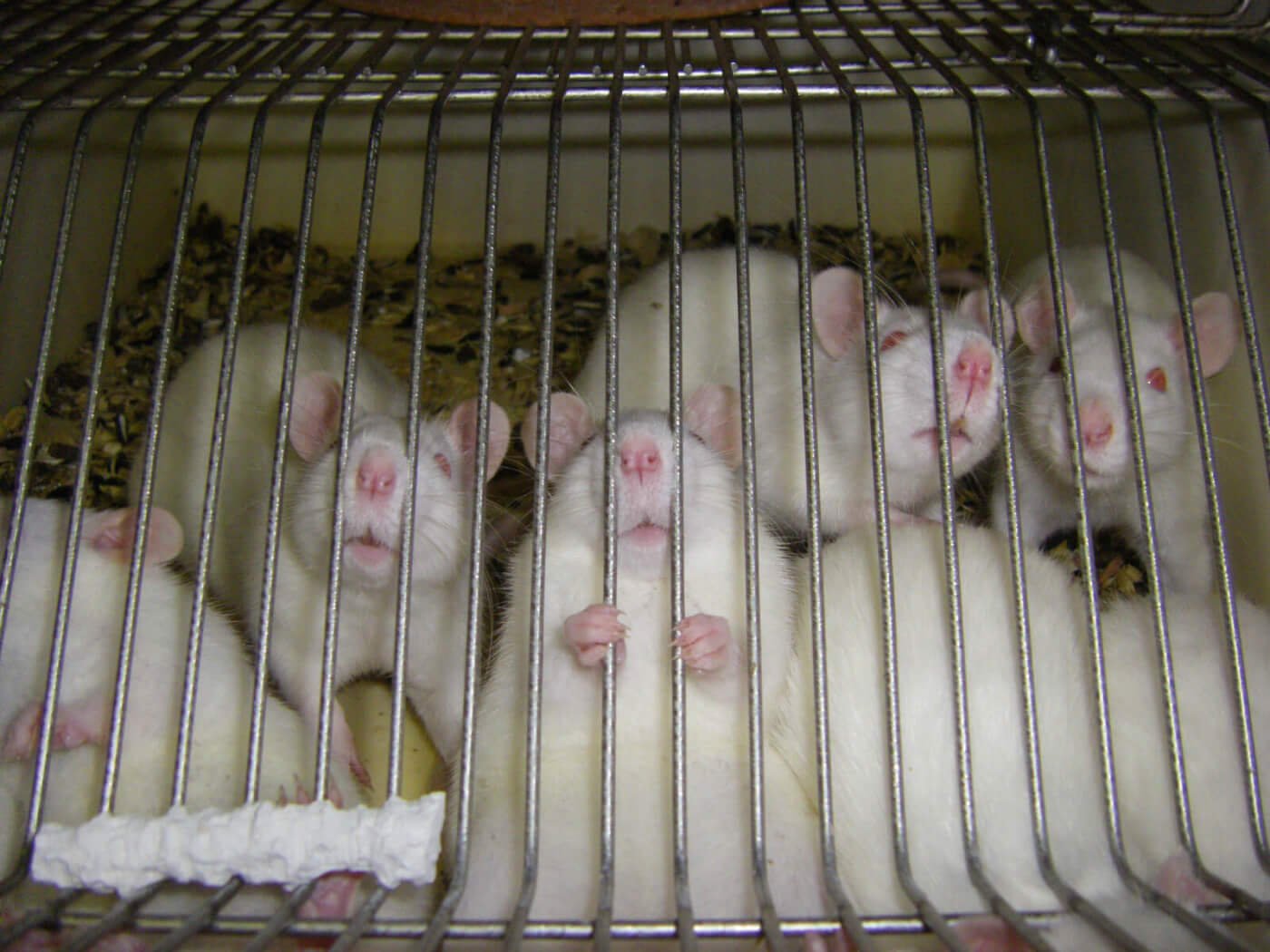 © Doctors Against Animal Experiments
© Doctors Against Animal Experiments
4. Between 2015 and 2019, more than 300,000 animals covered under the AWA were subjected to painful experiments without pain relief.
Rabbits haven't received whatsoever hurting relief in the Draize eye and pare irritation and corrosion tests since they started in the 1940s. In these tests, a substance is dripped into rabbits' eyes or smeared onto their shaved skin, leaving them to suffer from inflammation, ulcers, bleeding, irritated and cloudy eyes, blindness, redness, swelling, discharge, and hemorrhaging.

v. A 2009 survey found that mice and rats used in invasive, painful surgeries were only provided with post-operative pain relief about 20% of the time.
The survey found that mice and rats who were subjected to skull surgeries, burn experiments, spinal surgeries, and other horrors rarely received postal service-procedural hurting relief. Imagine someone drilling open your skull to betrayal your encephalon but non giving you then much every bit an Advil.
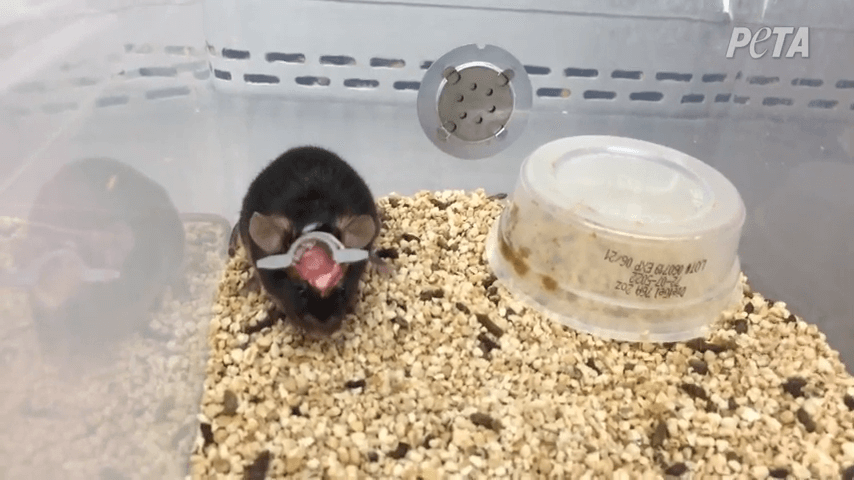
half-dozen. More 93% of experimental cancer drugs failed in the first stage of human clinical trials afterward testing "successfully" on animals.
The survey was based on most 4,500 cancer drugs developed between 2003 and 2011. Artificially inducing a condition in a healthy individual of a different species who is confined and isolated in stressful, unnatural conditions and then applying the results to naturally occurring diseases in humans is not only unethical but also ridiculous. Even fauna experimenters acknowledge that the extreme distress that these animals suffer jeopardizes the results.
We've been handicapped by the fact that we have been studying diseases in animals that don't really exist in animals. Mice … don't get schizophrenia. They don't go Alzheimer's illness.
—Dr. Christer Nordstedt, Eli Lilly'due south vice president of neuroscience research
7. The chemicals that cause cancer in rats simply cause information technology in mice 46% of the time.
If extrapolating from rats to mice is so unreliable, imagine the inefficiency of applying results from mice, rats, rabbits, dogs, and monkeys to humans. Richard Klausner, former caput of the National Cancer Plant, said, "The history of cancer research has been a history of curing cancer in the mouse. We take cured mice of cancer for decades and it merely didn't work in humans."
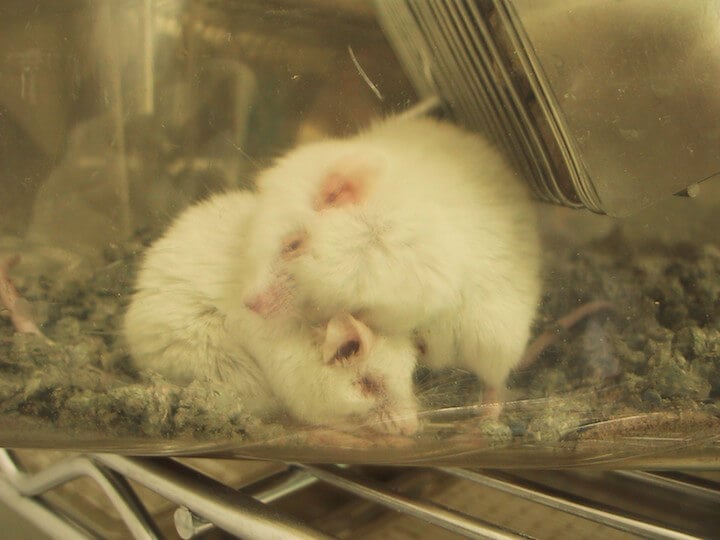
8. Ane hundred HIV vaccines have been successful in animal experiments—100% of them failed to protect humans sufficiently.
In 1 example, an HIV vaccine that was shown to be effective in monkeys failed in human clinical trials because it didn't prevent people from developing AIDS, and some believe that information technology made them more susceptible to information technology. According to a report inThe Independent, i conclusion was that "testing HIV vaccines on monkeys before they are used on humans, does not in fact work."
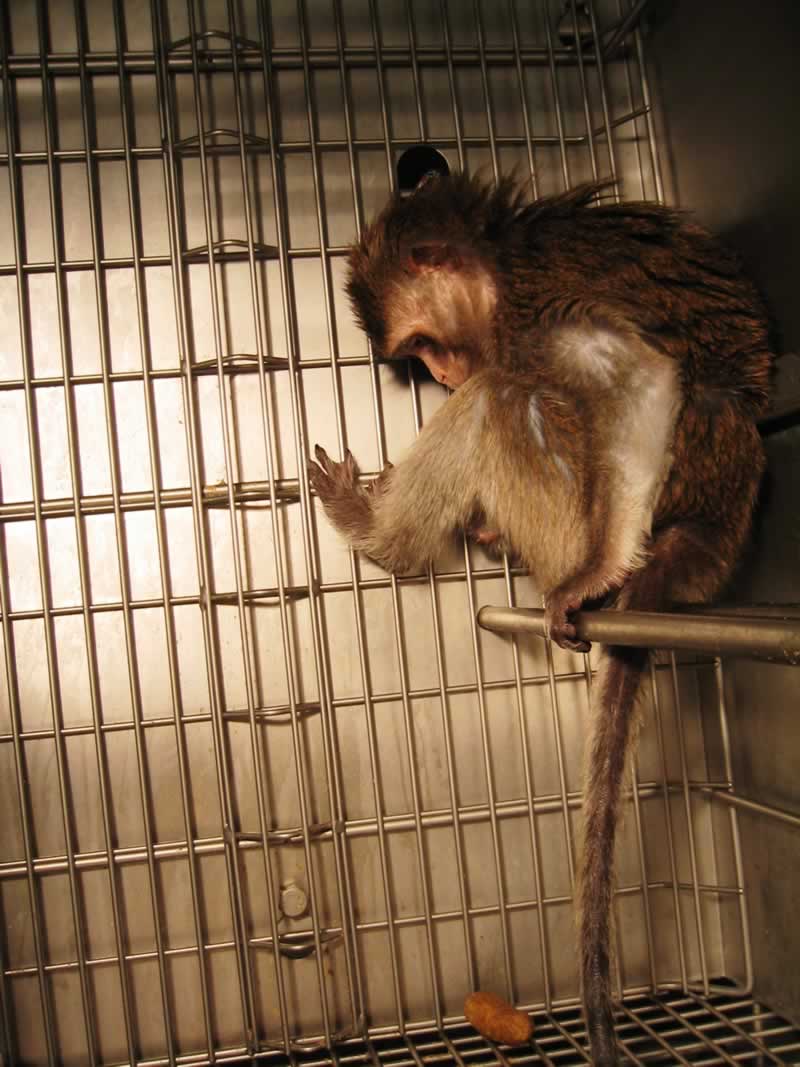
Monkeys used for experiments are often housed within tiny and virtually barren cages for their entire lives, deprived of everything that's natural and important to them.
9. Every twelvemonth in the U.S., NIH blows about 47% of enquiry funding on animal experimentation.
Approximately 47% of NIH-funded research involves animals, and in 2020, the agency budgeted well-nigh $42 billion for enquiry and development—that's $19.6 billion spent on creature experiments. Only for what? Do you know of any cures for multiple sclerosis, West Nile virus, or muscular dystrophy? Well, there aren't any. A 2014 review newspaper co-authored by a Yale School of Medicine professor in The BMJ documented the overwhelming failure of experiments on animals to ameliorate human health, terminal that "the public's standing endorsement and funding of preclinical animal enquiry seems misplaced."
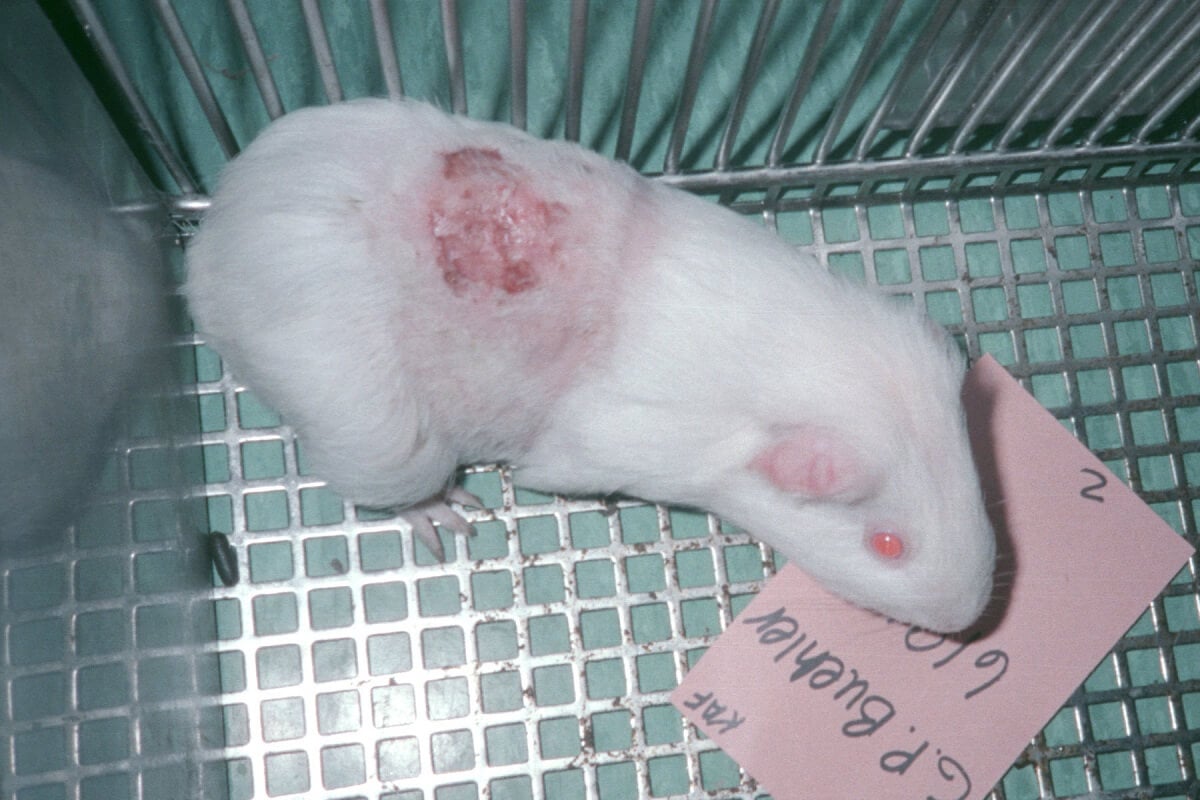
x. Currently, 52% of U.S. adults oppose the utilise of animals in scientific enquiry.
A Pew Inquiry Middle poll institute that the majority of American adults oppose the utilize of animals in scientific research, and other surveys suggest that the misguided folks who do support it but experience that manner because they wrongly believe that it's necessary. In an article published in The Journal of the American Medical Association, researchers found that medical treatments developed for animals rarely translated to humans and warned that "patients and physicians should remain cautious about extrapolating the finding of prominent creature research to the care of human illness … poor replication of even high-quality animal studies should be expected."
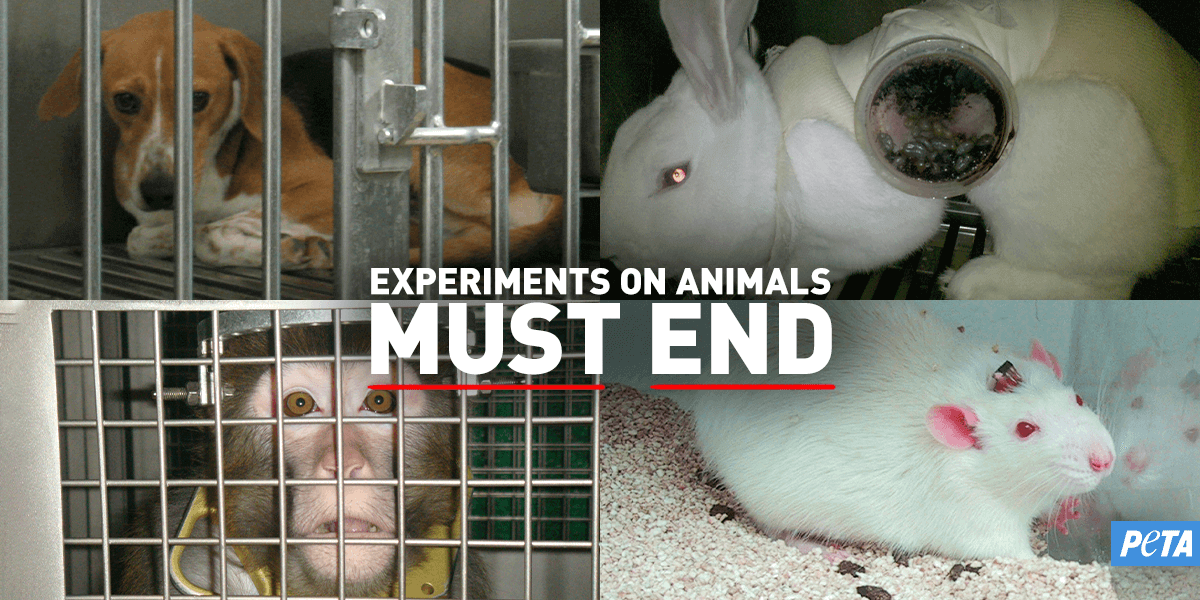
eleven. Since 2017, PETA U.Southward. has had nearly 150 victories for animals used in experiments.
Our victories include helping engineers develop a new ventilator for COVID-nineteen patients without animal testing, working with the Taiwan Food and Drug Administration to eliminate animal tests for health marketing claims for foods, persuading Suave to go cruelty-free, and getting pharma behemothic Bristol Myers Squibb and others to ban almost-drowning tests. PETA entities' work to end animal experiments—backed by the support of more than 9 million members and supporters worldwide—is saving endless animals.
*****
In NIH's about recent five-yr plan, the agency stated that "creature models oftentimes neglect to provide practiced ways to mimic disease or predict how drugs will work in humans, resulting in much wasted time and money while patients wait for therapies." Animal experiments are not a practiced indicator of drug responses in humans or any species other than the one being exploited. Penicillin is the courage of man antibiotics, notwithstanding it kills republic of guinea pigs! Aspirin kills cats and causes nativity defects in rats, mice, guinea pigs, dogs, and monkeys, and morphine, a depressant in humans, stimulates goats, cats, and horses.
All these animal testing statistics can be boiled down to simply one: Animate being experiments are speciesist—making them unacceptable 100% of the fourth dimension. They don't work, and even if they did, they'd yet be unacceptable. Torturing sensitive beings isn't OK, even if someone's pretending it's for scientific discipline or medicine—it'due south every bit simple every bit that.
Source: https://www.peta.org/features/animal-experimentation-statistics/
Posted by: warnerhipt1970.blogspot.com

0 Response to "How Many Animals Are Tested On Each Day"
Post a Comment